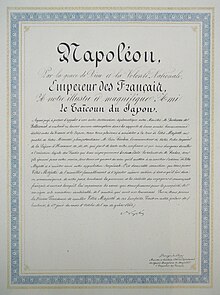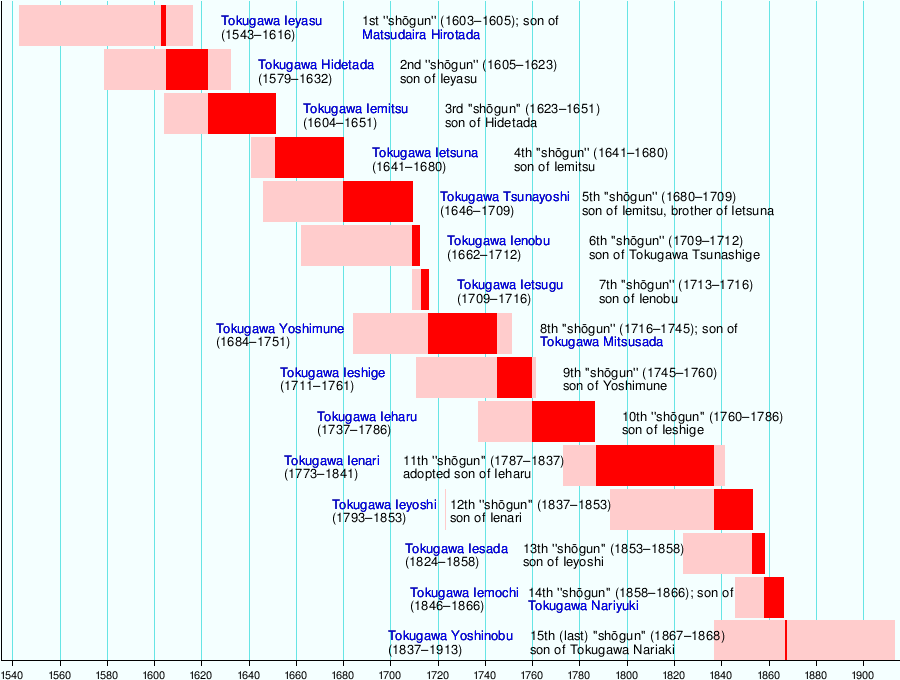Tokugawa Iemochi
Tokugawa Iemochi | |
|---|---|
 | |
| 14th Edo Shogun | |
| In office August 14, 1858 – August 29, 1866 | |
| Monarch | Emperor Kōmei |
| Preceded by | Tokugawa Iesada |
| Succeeded by | Tokugawa Yoshinobu |
| Personal details | |
| Born | July 17, 1846 Minato,Edo, Japan |
| Died | August 29, 1866 (aged 20) Osaka Castle, Japan |
| Spouse | Princess Kazu |
Tokugawa Iemochi (徳川 家茂) (July 17, 1846 – August 29, 1866) was the 14th shogun of the Tokugawa shogunate of Japan, who held office from 1858 to 1866.[1] During his reign there was much internal turmoil as a result of Japan's first major contact with the United States, which occurred under Commodore Perry in 1853 and 1854, and of the subsequent "re-opening" of Japan to western nations. Iemochi's reign also saw a weakening of the shogunate.[1]
Biography
Iemochi, known in his childhood as Kikuchiyo, was the eldest son of the 11th generation Wakayama Domain lord Tokugawa Nariyuki (1801–1846) with his wife known as ji-sein and was born in the domain's residence in Edo (modern-day Minato-ku in Tokyo). Nariyuki was a younger son of the 11th shogun, Tokugawa Ienari.
In 1847, at age 1, he was adopted as the heir of the 12th generation daimyo Tokugawa Narikatsu, and succeeded him in 1850, taking the name Tokugawa Yoshitomi following his coming of age in 1851. However, in 1858 he was adopted as Tokugawa Iesada's son and named as the successor to the main Tokugawa house due to his cousin the 13th shogun, Iesada, being heirless. The choice of Yoshitomi was not without conflict; there were other factions in the government who supported Tokugawa Yoshinobu or Matsudaira Naritami for shogun; it must be said that both of them, as opposed to Iemochi, were adults. It was upon assuming the office of shogun that Yoshitomi changed his name to Iemochi .
Iesada's will was that: First,Ii Naosuke must help Iemochi at administration until he old enough to rule. Second,Iesada is wife,Atsuhime (later Tenshoin)must be told all about Iemochi is Political affairs as Iemochi is foster mother.
On April 22, 1863 (Bunkyū 3, 5th day of the 3rd month), Shogun Iemochi travelled in a great procession to the capital. He had been summoned by the emperor, and had 3,000 retainers as escort. This was the first time since the visit of Iemitsu in the Kan'ei era, 230 years before, that a shogun had visited Kyoto.[2]
As part of the kōbu gattai ("Union of Court and Bakufu") movement, Iemochi was married to Imperial Princess Kazu-no-Miya Chikako daughter of Emperor Ninkō, and younger sister of Emperor Kōmei
His early death at the age of 20, put an end to his short marriage with princess Kazu no Miya. Before he died he adopted a son, Tayasu Kamenosuke as his heir. At that time Tayasu Kamenosuke was only 3 years old, but as the Tokugawa shogunate was at war with Satsuma, Yoshinobu was appointed the fifteenth shogun. After Iemochi's death, Kazu no Miya changed her name to Seikan'in no Miya. The cause of death is widely reported as heart failure due to beriberi, a disease caused by thiamine (vitamin B1) deficiency.
His successor, Tokugawa Yoshinobu, was the last Tokugawa shogun and witnessed the end of the shogunate, which gave way to the Meiji Restoration.
Eras of Iemochi's bakufu


The years in which Iemochi was shogun are more specifically identified by more than one era name or nengō.
In fiction
Tokugawa Iemochi is featured in the 2008 NHK Taiga drama, Atsuhime. He is portrayed by Matsuda Shota.
His child self is featured in the novel Kazunomiya, Prisoner of Heaven, by Kathryn Lasky, a fictional diary written by Iemochi's wife.
Iemochi is also mentioned in The Last Concubine by Lesley Downer.
He is parodied in the manga and anime series Gin Tama as "Tokugawa Shige-Shige" (徳川 茂茂), with a name based on Tokugawa Ieshige.
Lord Tokugawa appears in James Clavell's novel Gai-Jin as Nobusada Toranaga.
Notes
- ^ a b "Japan:Memoirs of a Secret Empire". PBS. Retrieved 2007-08-11.
- ^ Ponsonby-Fane, Richard. (1956). Kyoto: the Old Capital of Japan, 794–1869, p. 325.
References
- Rekishi Dokuhon Jan. 2006 issue: Tokugawa Shōgun-ke to Matsudaira Ichizoku
- Tokugawa Iemochi to sono jidai: wakaki shōgun no shōgai 徳川家茂とその時代: 若き将軍の生涯. Tokyo: Tokugawa kin'en zaidan 徳川記念財団, 2007.
- Totman, Conrad. (1980). The Collapse of the Tokugawa Bakufu, 1862–1868. Honolulu: University of Hawai'i Press. ISBN 978-0-8248-0614-9
External links
![]() Media related to Tokugawa Iemochi at Wikimedia Commons
Media related to Tokugawa Iemochi at Wikimedia Commons
- Digitized woodblock print: Shogun Iemochi in procession towards Kyoto in Bunkyū 3

